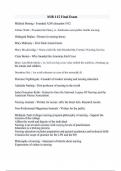Class notes
UofT PCL201 Study Notes
- Course
- PCL201 (PCL201)
- Institution
- University Of Toronto (U Of T )
Introductory course to pharmacology and pharmacokinetics, covering drug absorption, distribution, elimination, dosage, and response. Notes summarize lecture slides and concepts discussed in class. From 2020, taught by Dr. Cindy Woodland
[Show more]




